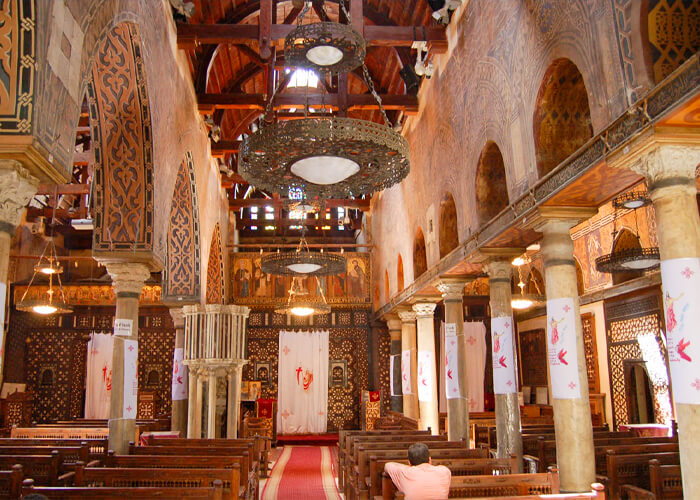It is Coptic in Cairo.
Among the topics covered:
Coptic Cairo’s history
Where to go first when you arrive
Hanging church’s long and fascinating history
The Ben Ezra Synagogue – St. George’s Church
Coptic A chronology of Cairo’s development
Masr al Qadima (Old Cairo) is one of Cairo’s oldest neighborhoods and a remarkable link between Egyptian pharaonic and Islamic cultures.
Moreover, it’s one of the city’s most popular tourist attractions.
In the 6th century BC, Babylon-in-Egypt was constructed here as a frontier station between Egypt and Babylon.
It’s not the Roman walls, but the little lanes dotted with early churches, including Egypt’s oldest synagogue, that make up the bulk of the area’s allure.
Cairo’s oldest mosque is the Amr Ibn al-As Mosque, which was built in AD 642 by Amr Ibn al-As.
What everyone wants to see when they get there
You’ll observe two Roman towers, built in AD 130 by Emperor Trajan as part of the city’s fortifications, as well as remnants of Babylon-in-walls, Egypt’s as soon as you arrive in Coptic Cairo.
The interesting Coptic Museum, newly renovated, is tucked away inside these walls and exhibits Coptic art from the Graeco-Roman era to the early Islamic period (from about AD 300 to 1000).
Researchers believe that pharaonic emblems may have inspired Christian symbols such as the cross and the image of the Virgin and Child.
While the Copts were known for their weaving, they left behind an impressive collection of early textile remains, which may be seen on the museum’s upper floor.
Hanging churches have a long and fascinating history.
This church was built on top of a Roman bulwark and is visible at the back of the building via a hallway next to the cafeteria. It is called the “Hanging Church.”
The building may be reached through a winding staircase and a vestibule selling Coptic goods.
However, some Coptic Christians think that the church was established far earlier than the 7th century.
Panels inlaid with bone and ivory hide the three haikals in its gloomy interior, which has cedar paneling and a wooden Ark-like roof, a marble pulpit supported by 12 Apostles’ pillars, and excellent 13th-century panels inlaid with bone or ivory (altars).
St. George’s Cathedral
The most historic building in the neighborhood is the Abu Sarga (St. Sergius) church, which dates back to the 5th century and has a crypt where the Holy Family is said to have slept during their exile in Egypt, according to legend.
For those who choose to receive a blessing, nuns at the Convent of St. George may chain their hands and feet.
The Ben Ezra Synagogue
While the Jewish community has long since disappeared, the Ben Ezra Synagogue at the opposite end of the street has been painstakingly restored to its former glory.
In the 11th century, the edifice was converted from a church to a mosque, although the interior decor remained surprisingly similar to that of the nearby Coptic Cario churches..
In the 6th century BC, Jews believe this was the site of Jeremiah’s prophecy, while the Copts consider it to be the site where a newborn Moses was found in a basket while traveling through Egypt.
What I’ve Learned
At order to hear the pharaohs’ voices, you must attend a Coptic Mass in the Hanging Church in Egypt, which is conducted from 8 a.m. to 11 a.m. every Friday and Sunday.
The music, instruments, and even the language seem disturbingly similar to those of ancient Egypt.
The Holy Family’s visit to the area is commemorated with a festival on June 1st.
Treasures still to be found
There is a beautiful 10th century icon of the Virgin and Child to the right of the entry to the Hanging Church, which bears Egyptian features on its faces.
You’ll find a hidden Christian cemetery behind the 11th-century St. Barbara’s church if you go via the back tunnels.

